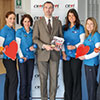Tag Archives: cardiovascular disease

December 2013 Br J Cardiol 2013;20(suppl 3):S1–S19 doi:10.5837/bjc.2013.s04
What is cardiac rehabilitation achieving for patients with CHD? The ASPIRE-2-PREVENT results
Kornelia Kotseva, Elizabeth L Turner, Catriona Jennings, David A Wood, on behalf of ASPIRE-2-PREVENT Study Group

The main objective of cardiovascular prevention and rehabilitation in clinical practice is to reduce the risk of future vascular events, to improve quality of life and increase life expectancy. Cardiac rehabilitation (CR) is recommended by the British Association for Cardiovascular Prevention and Rehabilitation (BACPR).1 This second edition of the Standards and Core Components (SCC) for Cardiovascular Disease Prevention and Rehabilitation from the BACPR, define CR through seven standards and seven core components for assuring a quality service of care using a multi-disciplinary biological and psychosocial approach.2 However, the implementatio
December 2013 Br J Cardiol 2013;20(suppl 3):S1–S19 doi:10.5837/bjc.2013.s05
Dyslipidaemia and atherosclerotic vascular disease: DYSIS results in the UK
Vian Amber, Kornelia Kotseva, Elizabeth L Turner, Catriona Jennings, Alison Atrey, Jennifer Jones, Susan Connolly, Timothy J Bowker, David A Wood, on behalf of the DYSIS Study Group UK

Background Statins are first choice for treatment of dyslipidaemia in both secondary and primary cardiovascular disease prevention. For every 1.0 mmol/L reduction in low-density lipoprotein cholesterol (LDL‑C), the risk of coronary heart disease (CHD) mortality decreases by 19% and overall mortality decreases by 12%.1 Despite statin treatment, a substantial number of cardiovascular events still occur, and one reason may be persistent lipid abnormalities including total cholesterol and LDL-C not at target, or low levels of high-density lipoprotein cholesterol (HDL-C) or elevated triglycerides. Results from the DYSlipidaemia International Stu
December 2013 Br J Cardiol 2013;20(suppl 3):S1–S19 doi:10.5837/bjc.2013.s06
The principles of MyAction
Catriona Jennings, Alison Atrey, Jennifer Jones, Kornelia Kotseva, David A Wood, on behalf of the MyAction Central team

The programme is implemented according to national evidence-based guidelines and local policies. The programme integrates primary and secondary prevention in one programme and recruits all those who will benefit the most, i.e. patients with vascular disease, those at high risk of developing disease, and the close family members of the above, and takes into account the groups in which the prevalence of cardiovascular disease and risk factors is the highest. The programme is family centred and so recruits the spouse and/or others close to the patient in order to maximise the potential for adoption of positive healthy behaviours. Wherever possib

December 2013 Br J Cardiol 2013;20(suppl 3):S1–S19 doi:10.5837/bjc.2013.s07
Delivering the MyAction programme in different populations: NHS Westminster, London
Susan Connolly, Adrian Brown, Sarah-Jane Clements, Christine Yates, Kornelia Kotseva, on behalf of Westminster MyAction teams

MyAction Westminster: background In response to the Department of Health (DoH) policy document Putting Prevention First,1 NHS Westminster launched its Health Checks programme in primary care in 2009. The MyAction Westminster programme was concomitantly commissioned by NHS Westminster so that those individuals identified to be at high cardiovascular disease (CVD) risk through the Health Checks could access, with their families, an effective vascular prevention programme that would help them achieve measurably healthier lives. Imperial College Healthcare NHS Trust were successful in becoming the providers of the programme with an annual budget

December 2013 Br J Cardiol 2013;20(suppl 3):S1–S19 doi:10.5837/bjc.2013.s08
Delivering the MyAction programme in different populations: Galway, Republic of Ireland
Irene Gibson, James Crowley, Jennifer Jones, Claire Kerins, Anne Marie Walsh, Caroline Costello, Jane Windle, Gerard Flaherty, on behalf of Croí MyAction team

Background Cardiovascular disease (CVD) is the single most common cause of death in Ireland, with diseases of the circulatory system accounting for 33.5% of deaths.1 While there has been a significant decline in death rates over the last 30 years, CVD mortality rates in Ireland remain high in comparison with European averages.2 There is compelling evidence that managing risk factors through lifestyle intervention and cardioprotective drug management can reduce cardiovascular morbidity and mortality by up to 90%.3 In Ireland, high-risk approaches to prevention have traditionally targeted those with established heart disease, yet there are many

December 2013 Br J Cardiol 2013;20(suppl 3):S1–S19 doi:10.5837/bjc.2013.s09
Training opportunities in preventive cardiology: MSc, Diploma and Certificate in Preventive Cardiology
Jennifer Jones, Suzanne Barr, Catriona Jennings, Tim Grove, Kornelia Kotseva, Susan Connolly, Anne Dornhorst, Gary Frost, Paul Bassett, David A Wood

Introduction The scientific evidence for cardiovascular (CVD) disease prevention is compelling but, as demonstrated by the EUROASPIRE and ASPIRE-2-PREVENT surveys, translating this evidence into effective patient care in the real-world in clinical practice is challenging.1,2 However, the same academic group have undertaken a number of trials and have shown that it is possible to implement national and international clinical guidelines and achieve the lifestyle, medical and therapeutic targets associated with reduced cardiovascular events and improved health outcomes.3-5 In recognising the need to bridge the implementation gap for prevention a

July 2013 Br J Cardiol 2013;20:90–1 doi:10.5837/bjc.2013.020 Online First
Islam and the cardiovascular patient – pragmatism in practice
Hassan Chamsi-Pasha

The heart is extensively described in multiple Qur’anic verses and prophetic traditions as both an organ of psyche, intelligence and emotion, as well as an important organ that can be harmed by several factors.2 The prophet Muhammad, Peace Be Upon Him (PBUH), stated: “Beware! There is a piece of flesh in the body if it remains healthy the whole body becomes healthy, and if it is diseased, the whole body becomes diseased. Beware, it is the heart”.3 This tradition holds true if taken either literally or spiritually. Fasting Ramadan and performing Hajj (Pilgrim) may pose problems to patients with cardiovascular disease, hence, it is import
August 2012 Br J Cardiol 2012;19:107–10
New ESC Guidelines on heart failure and CVD prevention
News from the world of cardiology

Heart failure The recommendations on devices, drugs and diagnosis in heart failure were developed by the ESC in collaboration with a heart failure association of the ESC. There have been several major updates since the previous guidance published in 2008. The new updates include: In devices, left ventricular assist devices (LVADs) have been hailed as a step change in the management of heart failure. LVADs are more reliable and lead to fewer complications than in 2008. Until now, LVADs have been used as a temporary measure in patients awaiting a heart transplant. Professor John McMurray (Glasgow, UK), chairperson of the ESC Clinical Practice

August 2012 Br J Cardiol 2012;19:112–3
In brief
BJCardio Staff

EVINCI study completed The prevalence of “significant” coronary artery disease in patients with chest pain symptoms is lower than expected in Europe, according to preliminary findings from the The EValuation of INtegrated Cardiac Imaging (EVINCI) study. Once the final analysis is completed, the EVINCI study is expected to demonstrate that performing adequate non-invasive imaging screening of patients with suspected coronary artery disease could safely avoid invasive procedures in 75 out of 100 patients. The study will have sufficient power to answer the question of which is the most cost-effective non-invasive imaging strategy for the j

May 2012 Br J Cardiol 2012;19:79–84 doi:10.5837/bjc.2012.016
Omega-3 fatty acids in cardiovascular disease: re-assessing the evidence
Alan Begg, Susan Connolly, Julian Halcox, Agnes Kaba, Linda Main, Kausik Ray, Henry Purcell, Helen Williams, Derek Yellon

Background Observations on fish consumption in general Populations who consume large amounts of oily fish in their diet tend to have lower rates of coronary heart disease (CHD) and sudden cardiac death (SCD). Fish oils are rich in omega-3 polyunsaturated fatty acids (PUFAs), which have demonstrable cardioprotective properties. In line with these observations, extensive epidemiological data – including large meta-analyses – demonstrate clear associations between both increased fish consumption and increased omega-3 PUFA levels with a favourable cardiovascular prognosis.1-3 Most of the evidence for benefits has been observed in individuals

